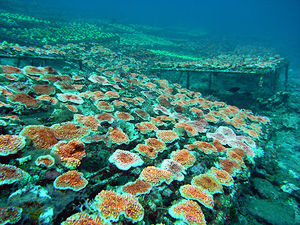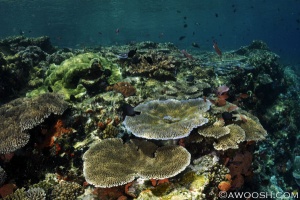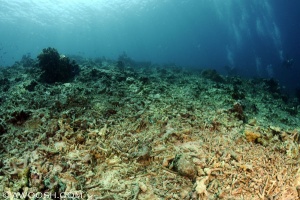CoralTrade
The Coral Trade
Demand and Use of Coral: Business Behind the Trade
The Coral Trade has been around for ages and is nearly impossible to trace back to a single event or time period. From the first days that humans discovered the underwater world of coral reefs they were fascinated by it and wanted to conquer it and owning coral was made into a status symbol. In the 19th century, it was customary for young English gentlemen to spend a few months, even years, on a “grand tour” of Europe, returning home with mementos that might have included trinkets of coral from this Neapolitan community at the foot of Mount Vesuvius. Convinced that it warded off evil spirits, the Victorians, like the ancient Romans and Egyptians, prized Corallium rubrum, the precious red coral species found in the deep waters of the Mediterranean. Coral continued to enjoy a special place among jewelry and fashion lovers, until fairly recently.[1]
Current Views on the Coral Trade:
Now, some jewelers have stopped using it, worried about the environmental effect that the trade has had. Campaigners also want to offer red coral more protection from over-fishing. But others, particularly those who rely on coral for their livelihood, believe they should be allowed to continue working with the beautiful species, in a sustainable way.
Tiffany, the high-end U.S. jeweler, stopped selling coral in 2002. Other companies like Stephen Dweck and Temple St. Clair have since followed suit.Tiffany signed on as a sponsor when the nonprofit group SeaWeb, based in Maryland, started a “Too Precious to Wear” campaign to promote coral conservation in January 2008. Yet not every jeweler sees the issue in the same terms. Robert M. Taylor, president and chief executive of Maui Divers Jewelry, the largest jewelry retailer in the Hawaiian Islands, said he believed in coral conservation. However, he took issue with the “Too Precious to Wear” campaign’s core message that corals are in crisis, suffering from high consumer demand and, hence, should not be used in jewelry. “It’s the opposite of what we feel,” he said. “Precious coral is too precious not to wear.” [2]

Unlike the Corallium (pink and red coral) which is the target of the SeaWeb campaign, the precious black coral that makes up the bulk of Maui Divers’ coral sales is already listed on Appendix II of the Convention on International Trade in Endangered Species, known as Cites. The listing does not ban the sale of black coral; it does, however, mandate a strict reporting regime designed to prove that trade is “not detrimental” to the species’ survival in the wild. Which makes it hard to enforce and monitor.
Uses of Coral Beyond Jewelry
Coral is used for a variety of different things from jewelry as mentioned previously to construction, medicine and is traded amongst avid aquarium collectors. On the international level the U.S. imports more coral for aquarium use than any other country. While coral jewelry sales are on the decline the live trade of coral for aquariums is continuing to rise in popularity. This becomes an issue as policies vary from country to country so they can be obtained in illegal manners in a different country and then shipped into the United States. This issue is discussed later on in this article. There is a current shift to aquaculture instead of wild harvesting in current years. This shift suggests that, contrary to the conventional view that the live coral trade is a threat to coral reef ecosystems, the buying and selling of corals could help create a powerful incentive for protecting reefs in many small island communities, these scientists say. “The difference in a year is staggering,” said the study’s lead author, Andrew Rhyne, an assistant professor of marine biology at Roger Williams University.[3]
Particularly in Indonesia, the world’s largest supplier of stony corals and home to more coral reef areas than any other nation, many producers have “learned that if you collect a really beautiful, interesting coral, if you export that, you get to export it one time,” Dr. Rhyne said. “If you keep it and farm it, you get to export it forever.”

As far as coral as a building material is concerned the most popular use on land is coral rag. The corals provide lime for use as building blocks. Coral rag is an important local building material in places such as the East African coast. Coral is also used in medicine. The pharmaceutical company, Bristol-Myers Squibb in the recent year has liscenced and patented a chemcial from the coral Elutherobia called eleutherobin. Eleutherobin is able to bind a protein material within cellular structures called microtubles and make them extremely rigid, a process that prevents cancer cells from dividing. It works in a similar manner to taxol a recent breakthrough in breast and ovarian cancer. Coral is also used for bone grafts using a product named hydroxyapaitite (HA), this is made from the exoskeletons of marine coral. HA is similar in structure to bones in humans. This allows it to fill voids from trauma and fractures to upper portions of the long bones. The FDA has approved the HA product known as Pro Osteon Implant 50 made by the company Interpore International since 1992. When implanted into a void the web-like structure allows it to surround the bone and fibrous tissues to infiltrate the implant and it becomes a part of the body biologically. [6]
Ethical Concerns Behind the Trade Culture
Coral reef creatures and coral are often captured and for the exotic pet trade, resulting in inhumane treatment and trade practices. These practices will destroy the wildlife populations in the coral reef ecosystem, which the animals- and humans- depend on. It has been research proven that fish undergo a lot of physical and mental damage during the trade process. The symptoms of the fish are characterized as “post traumatic shipping disorder.” Often times fish and other sea creatures get overlooked as non animal creatures; however, just like humans sea creatures undergo the same hormone effects as well. In a recent study, marine biologist researched a group seahorses being shipped to an aquarium. They took blood samples and they tested positive for an increase in cortisol, also known as the stress hormone. The seahorses also tested for an increase in level of glucose in blood stream as well as decrease in serotonin. All of these symptoms-similar to humans- are indicative of stress. The increase of stress levels can lead to depression, loss of appetite, illness, and sometimes death. [7]
According to Stephanie Yue Cottee, a researcher at the University of Guelph in Canada, the average animal survives no more than 8 months in an aquarium setting, and by then the animal has already suffered a significant amount of pain, fear, and distress. The Hawaiian reefs are a huge pet trade hub and each year approximately 15,000 fish die before they can even be shipped out of Hawaii. Often times there will be an number of yellow tangs found in the dumpsters of these trading markets. The number of fish deaths is based on officially reported numbers, but many experts think the actual mortality rate is two to five times higher. [8]
Legal issues and Policies on Coral Reef Trade
Executive Order no. 13089 for the Protection of Coral Reefs On June 11, 1998, President Clinton issued the Executive Order 13089 on Coral Reef Protection. This executive order strived to “preserve and protect the biodiversity, health, heritage, and social economic value of U.S coral reef ecosystems and marine environment.” This order also established the U.S Coral Reef Task Force, co-chaired by the Secretary of Interior and Secretary of Commerce through two organizations: Administrator of National Oceanic and Atmospheric Administration (NOAA).
The U.S Coral Reef Task Force was responsible for duties and responsibilities, listed below.
- Coral Reef Mapping and Monitoring: Working with State, commonwealth, and local government ot map and monitor U.S coral reefs, such as National Marine Sanctuaries, National Parks, and other coral reef resources.
- Conservation, Mitigation, and Restoration. Working with different coral reef related organizations to develop ways to restore damaged coral reefs, and mitigate further coral reef degradation. These policies include finding solutions to water pollution, over-fishing, over-use, collection of coral reef species, etc.
- International Cooperation. Develop and spread the U.S. role in international trade and protection of coral reef species. Create and implement appropriate strategies to promote conservation and sustainable use of coral reef resources worldwide.
- Research: Working with scientific community to conduct researched aimed at identifying major causes and consequences for the damages done on coral reef ecosystems.[9]
Convention on International Trade in Endangered Species of Wild Fauna and Flora (CITES) The World Trade Organization has been trying to implement a couple policies; however, because of the widespread culture of coral reef trade it is still hard to regulate. Policies include, creating incentives for responsible collection management, random fish testing through establishing cyanide testing facilities, charge more export fees, and develop on replenishment reserves for coral reef animals and creatures. [10]
Destructive Practices of the Coral Trade
Removing Reefs and Methods


- Bombing: Also known as Blast Fishing, where fishermen create bombs and throw them into the water by killing fish and destroying coral, the bombs make it easy for fishermen to catch food fish. This practice is prohibited in most countries, but is still practiced in Asia, Africa, the South Pacific and the Caribbean. On average, one bomb can destroy thousands years of coral development and growth. This technique is also used to break apart chunks of coral to be traded for jewelry, medicinal, and tourism uses. [13]
- Cyanide Poisoning : Many aquarium fish are captured with sodium cyanide, which is a poison that stuns fish and makes them easier to collect. Cyanide not only destroys coral reef habitats and other plants and animals, it also slowly kills the captured fish as well. Almost 80 percent of the marine aquarium fish sold internationally come from the Philippines, many caught by cyanide fishing. [14]
- Live Coral Removal: Often times the live coral is ripped away from its habitats and then quickly transported to aquariums, the coral goes into shock as it is removed from its environment and corals being immobile creatures are even more ill prepared to move locations than fish. The polyps are also collected and then grown in coral labs. The coral being removed from the ecosystem also takes away homes and protection from the creatures that inhabit the reef. This is detrimental because the polyps being taken away from their natural environment slows the growth of the reef. [15]
Why Coral Reefs Are so Important and Should Be Protected
- As the foundation for complex food webs, coral reefs support an incredible diversity of fish. Algae, soft coral, sponges and invertebrates create the base of this web. From small herbivorous fish to large predatory fish, all find food and protection on the reef. Fish aside the reef is also home to an equally diverse array of marine crustaceans, mammals, and reptiles. Each of these animals plays in important role whether it be filtering water, consuming prolific algae or keeping a particular species under control. Removing a coral that supports just one of these species can throw the entire ecosystem out of balance.
- Corals as well as sponges are filter feeders, this means that they take particulate matter in the water column and consume it. This contributes to the clarity of water near shores, which draws in more tourists. Coral reefs often form the bulk of tourism for local economies. The tourists come for dive boats and snorkeling but while there need to eat at restaurants, a hotel to sleep in, and other forms of entertainment. Having healthy reefs boots all areas or tourism for coastal economies.[16]
- The reefs also serve as a barrier from surges and tropical storms. Barrier reefs (such as in Australia and off the coast of Florida) were named so because of they way they reduce waves and buffer the shore. These reefs help prevent erosion which is important in places like Florida where there are many residential homes along the coast. They also protect and help stabilize seagrass beds and mangroves which could easily be uprooted by stronger and larger waves.
- On top of it all reefs also create a habitat for many of the fish species we consume. This is important because fish and other marine life has been a primary source of protein for many individuals especially those residing along the coast. Local fisheries for lobster, snapper, grouper, and crab all directly rely on the reef for it the habitat in which these species spawn.[17]
Sources
- ↑ Green, E.P. and Shirley, F. 1999. The Global Trade in Corals. World Conservation Monitoring Centre. World Conservation Press,Cambridge UK.
- ↑ Garthwatie, Josise. "Reimaging the Coral Trade." The New York Times, December 17, 2012. http://green.blogs.nytimes.com/2012/12/17/finding-a-place-for-coral-farms-in-a-changing-ocean/ (accessed April 7, 2013).
- ↑ Wolf Arntz, et al. “Red Coral Fishery At the Costa Brava (NW Mediterranean): Case Study of an Overharvested Precious Coral” Ecosystems 10.6 (2007): 975-986. Academic Search Complete. Web. 27 Feb. 2013
- ↑ http://green.blogs.nytimes.com/2012/12/17/finding-a-place-for-coral-farms-in-a-changing-ocean/
- ↑ Wolf Arntz, et al. “Red Coral Fishery At the Costa Brava (NW Mediterranean): Case Study of an Overharvested Precious Coral” Ecosystems 10.6 (2007): 975-986. Academic Search Complete. Web. 27 Feb. 2013
- ↑ Bruckner, A. (2002). Life-Saving Products from Coral Reefs. Issues in Science and Technology. Spring Ed.
- ↑ Gradwhol, Judith. "Helping Hands." Ocean Planet:Perils-Terrible Tackle. Ocean Planet, n.d. Web. 17 Apr. 2013.
- ↑ Best, Barbara. "International Trade in Coral Reef Animals: Causes, Consequences and Courses of Action." (2010): n. pag. Print.
- ↑ "U.S. Coral Reef Task Force." Home. US EPA, n.d. Web. 17 Apr. 2013.
- ↑ "Global Trade and Consumer Choices: Coral Reefs in Crisis." Coral Reefs in Crisis. N.p., 2008. Web. 26 Feb. 2013.
- ↑ http://awoosh.com/blog/?p=1394
- ↑ http://awoosh.com/blog/?p=1394
- ↑ Bruckner, Andrew W. "New Threat To Coral Reefs: Trade In Coral Organisms." Issues In Science & Technology 17.1 (2000): 63. MasterFILE Complete. Web. 26 Feb. 2013.
- ↑ Bussoletti, Ezio. "Proceedings of the International Workshop on Red Coral Science,Management, and Trade: Lessons from the Mediterranean." U.S. Department of Commerce (2009): 1-244. Print.
- ↑ Knittweis, Leyla, and Matthias Wolff. "Live Coral Trade Impacts On The Mushroom Coral Heliofungia Actiniformis In Indonesia: Potential Future Management Approaches." Biological Conservation 143.11 (2010): 2722-2729. Academic Search Complete. Web. 23 Apr. 2013.
- ↑ Anderson, . Reef Relief , "Reef Relief." Last modified 02 05, 2013. Accessed April 11, 2013. http://reefrelief.org/the-importance-of-coral-reefs/.
- ↑ Richard E. Dodge, et al. "Coral Reefs." Annals Of The New York Academy Of Sciences 1162.(2009): 136-186. Academic Search Complete. Web. 27 Feb. 2013.